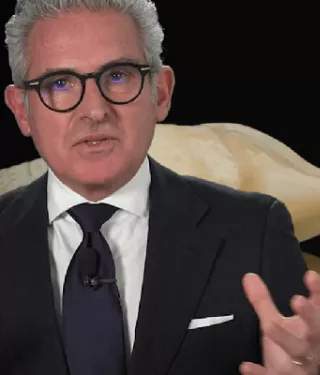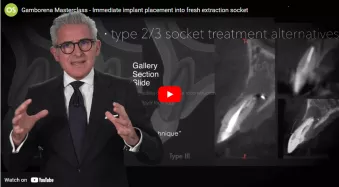
“If you don’t plan, you’re planning to fail”
Dr. Iñaki Gamborena presents on immediate implant placement in fresh extraction sockets
Dr. Gamborena, who should participate in your Masterclass on immediate implant placement?
This course has something for all dental professionals interested in the immediate placement of implants, who want to learn about the different elements. It will show dentists who are unfamiliar with it what’s possible, and for experienced dentists, a better understanding of why immediate placement is the best option for patients.
Of course, less experienced dentists might not be able to perform all the treatments that I’ll be showing, but they’ll definitely get a better understanding of what potential issues can arise. This is because I present my own real cases – even those where I encountered problems – and then show how what these cases look like 12, even 15 years down the road after the problems have been fixed.
What are some of the most common causes of failure for esthetic immediate implant treatments? Is this covered in the course?
The main cause of failure in these cases is gingival recession. If you don’t compensate for it, there will be major problems. Through this course, I want to remind dentists that you have to compensate – that resorption is going to occur regardless of what you do, but that it also depends on how careful you are and how much planning is involved. If you don’t plan, you’re planning to fail.
Among the topics you’ll be covering in your masterclass is connective tissue grafting (CTG) and, specifically, maxillary tuberosity CTG. Can you explain why CTG is one of the most challenging treatments in dentistry and what the benefits of this approach are?
As a periodontist, I’ve seen many colleagues use the palate as the connective tissue donor site since it’s easy to access and often has a lot of tissue. One of the problems with the palate, though, is that it has a lot of adipose tissue that interferes with healing and can increase resorption.
What we want is to have the densest soft tissue, which is actually in the back of the mouth at the maxillary tuberosity. This tissue is often thicker and has less adipose tissue, and grafting from this area is less painful for the patient than conducting CTG using the palate. However, the major challenge is that accessing the maxillary tuberosity can be difficult due, in part, to the limited working space and presence of wisdom teeth. Being able to access this area effectively, then, is really reliant on good technique.
Digital solutions are covered in the course. What role does digital planning play for you in the long-term success of immediate implant placement?
I think it’s essential that you plan with digital software like DTX Studio Implant because the quality of information and guidance that it gives you on where to place the implant is just amazing. Even if you’re extremely experienced, this kind of planning and guided surgery is able to really deliver benefits by showing you where the bone housing is, where the difficulties lie and so on. In the course, I’ll also highlight how we use DTX Studio Implant to communicate any difficulties to the dental technician and how it can be used by dentists at all levels of experience to reduce human error and choose which implants to use.
In this course, you teach an 8-step contemporary protocol. Are there any steps that are particularly crucial to surgical success?
In this protocol, the most important of the eight steps is placing a provisional crown on the tooth that will be extracted. If you don’t place a provisional that has the same contours as the tooth that was there, there can be a small recession and so by already having a crown in place, you are able to simplify treatment and replicate the contours, the contact points and the implant depth more easily.
It’s a philosophy that isn’t yet widely practiced – some dentists think that creating a provisional beforehand will take up too much time, but I think that it provides invaluable additional information about the restoration site. Overall, the 8-step protocol can be adapted to any kind of implant and helps the dental team achieve predictable long-term esthetic results.
In the course, though you primarily focus on anterior immediate placement, there is also consideration of immediate placement in the posterior region. Is there much difference in the skill and technique needed for each region?
Of course, implants in the posterior region don’t necessarily need the same esthetic approach because they’re less visible, but it really depends on your own expectations. You can apply the same CTG concept to posterior restorations and achieve fantastic results for the patient in the long term.
What do you think dentists will take away from your Masterclass?
Once they’ve participated, they certainly won’t be indifferent to the potential esthetic immediate implant treatments they can provide for their patients. Whereas they might initially think that taking soft tissue from the maxilla tuberosity is too difficult and beyond their knowledge or skill level, this Masterclass will show the steps and protocol needed to achieve better esthetic results and predictable, successful long-term outcomes that ultimately benefit the patient.

Dr. Iñaki Gamborena’s Masterclass introduces a comprehensive approach to optimize the functional and esthetic results of immediate implant placement into fresh extraction sockets by merging surgical, technical and restorative steps into one successful protocol. Immediate surgical and restorative protocols facilitate superior esthetic and functional success. This Masterclass will mainly address the key elements of advanced esthetics and implant dentistry, critical thinking, and the importance of CTG, and give all participants the chance to interact with one of the world’s leading experts in the field.